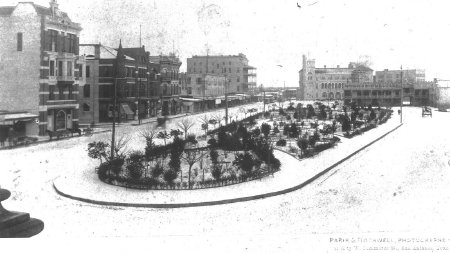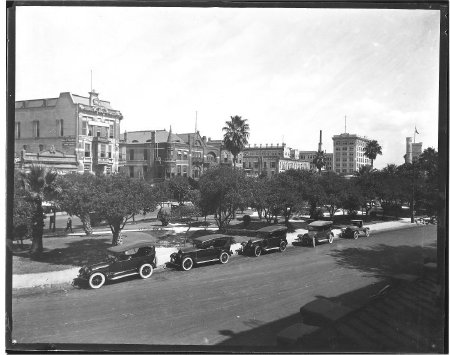History:
By the late 19th century, the northwest side of the former mission courtyard had given way to more substantial buildings and civilized amenities. The sons of pioneer Samuel A. Maverick built two of the earliest multistory buildings, the Crockett Block (1882) and the Maverick Bank (1884), on land inherited from their father's sizable holdings on the plaza. Other improvements, such as mesquite block paving (1888) and landscaping (1889) made the area cleaner and more inviting.
Alderman Anton Wulff (1822-1894), a native of Hamburg, Germany, personally supervised the landscaping for all of the plazas. Residents honored him for his work in transforming spaces that were "empty lots, littered with refuse, unsightly and unsanitary," to tropical landscapes and a "bower of greenness" ("A Neat Compliment;" "The Old Mud Square"). Much of the plant life on the plazas and parks was tropical, with Alamo Plaza having over 50 kinds of plants and shade trees. ("Plazas of San Antonio").
Alderman Anton Wulff (1822-1894), a native of Hamburg, Germany, personally supervised the landscaping for all of the plazas. Residents honored him for his work in transforming spaces that were "empty lots, littered with refuse, unsightly and unsanitary," to tropical landscapes and a "bower of greenness" ("A Neat Compliment;" "The Old Mud Square"). Much of the plant life on the plazas and parks was tropical, with Alamo Plaza having over 50 kinds of plants and shade trees. ("Plazas of San Antonio").
About this Image:
1.) Looking northwest from the center of Alamo Plaza after a rare snowfall. Notice the young plants in the park. From left to right: Reuter Bldg. (1891), Grand Opera House (1886), Wickes Bldg. (1886), Crockett Block (1882), Maverick Bldg. (1884), Post Office (1890), Hugo-Schmeltzer warehouse, and Alamo church.
2.) This later photo shows a more mature park landscape with lush palms, designed "to afford pleasure to the citizens, strangers, and winter visitors who come rom the bleakness of northern climates to see the all-year-round greenness of San Antonio." Also visible in the background from left to right are the Reuter Building, Opera House, Wickes Building, Crockett Block, Gibbs Building (1908), and Post Office.
2.) This later photo shows a more mature park landscape with lush palms, designed "to afford pleasure to the citizens, strangers, and winter visitors who come rom the bleakness of northern climates to see the all-year-round greenness of San Antonio." Also visible in the background from left to right are the Reuter Building, Opera House, Wickes Building, Crockett Block, Gibbs Building (1908), and Post Office.
To Learn More:
Credit:
Courtesy of San Antonio Conservation Society Foundation


